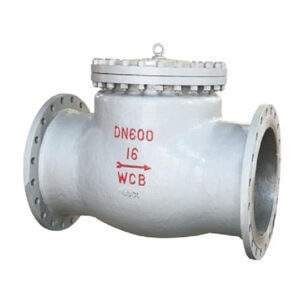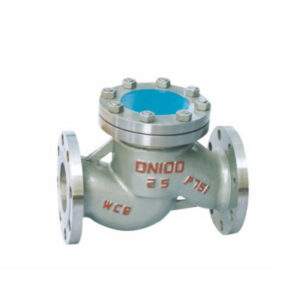Introduction

A check valve for water pump, sometimes referred to as a non-return valve or one-way valve, is a crucial component in many fluid handling systems. Its primary function is simple yet vital: to allow fluid flow in only one direction and prevent backflow. This seemingly small device plays a significant role in protecting pumps, pipelines, and other equipment from damage and ensuring the efficient operation of the system. In essence, a check valve for water pump acts as a silent guardian, preventing costly problems that can arise from reverse flow. This article explores the numerous benefits of using a check valve for water pump, delving into its various applications, types, and importance in different settings.
Understanding the Working Principle of a Check Valve for Water Pump
Before diving into the benefits, it’s essential to understand how a check valve for water pump operates. The basic principle is based on pressure differential. When the pressure on the inlet side of the valve is greater than the pressure on the outlet side, the valve opens, allowing fluid to flow through. Conversely, when the pressure on the outlet side becomes greater (indicating a potential backflow), the valve automatically closes, preventing any reverse movement of the fluid.
This operation is typically achieved through a simple mechanical design. Common types of check valves for water pump include:
- Swing Check Valves: These valves use a hinged disc (or clapper) that swings open to allow forward flow and closes against a seat to prevent backflow.
- Lift Check Valves: In these valves, a disc or ball is lifted by the forward flow and falls back onto the seat when the flow stops or reverses.
- Spring Check Valves: These valves utilize a spring to assist in closing the valve, making them suitable for applications with low flow rates or fluctuating pressures.
The simplicity of these mechanisms ensures reliable operation and minimal maintenance, making the check valve for water pump a practical and cost-effective solution for preventing backflow.
Key Benefits of Using a Check Valve for Water Pump

The use of a check valve for water pump offers a multitude of benefits, contributing to the overall efficiency, longevity, and safety of the system. Some of the key advantages include:
Preventing Backflow and Water Hammer
One of the most significant benefits of a check valve for water pump is its ability to prevent backflow. Backflow can cause several problems, including contamination of the water supply, damage to the pump impeller, and water hammer. Water hammer, a sudden pressure surge caused by the abrupt stopping of fluid flow, can lead to pipe rupture and damage to other components. A check valve for water pump effectively mitigates these risks by immediately closing upon flow reversal, preventing pressure spikes and protecting the system.
Protecting the Water Pump from Damage
Without a check valve for water pump, the pump itself is vulnerable to damage from backflow. Reverse flow can cause the pump impeller to spin in the wrong direction, leading to wear and tear, and in severe cases, even breakage. By preventing backflow, the check valve safeguards the pump, extending its lifespan and reducing maintenance costs.
Maintaining System Efficiency
A check valve for water pump helps maintain system efficiency by ensuring unidirectional flow. This prevents energy loss due to fluid recirculation and ensures that the pump operates at its optimal performance level. In systems where fluid is pumped uphill or over long distances, a check valve is crucial for preventing the fluid from flowing back down when the pump is turned off, thereby reducing the workload on the pump during subsequent start-ups.
Ensuring System Priming
In some pump systems, especially those involving suction lift, it is essential to maintain prime (i.e., keep the pump casing filled with liquid) to ensure proper operation. A check valve for water pump installed at the pump’s suction inlet helps retain the prime by preventing the liquid from draining back into the source when the pump is not running. This ensures a quicker and more reliable start-up each time.
Preventing Contamination
In applications where the pumped fluid is used for drinking water or other sanitary purposes, preventing backflow is crucial to avoid contamination. A check valve for water pump acts as a barrier, preventing potentially contaminated water from flowing back into the clean water supply. This is particularly important in situations where there is a risk of back siphonage, such as when there is a sudden drop in water pressure in the supply line.
Reducing Maintenance Costs
By protecting the pump and other system components from damage caused by backflow and water hammer, a check valve for water pump significantly reduces maintenance costs. The need for repairs and replacements is minimized, leading to long-term cost savings.
Enhancing System Reliability
The simple yet effective design of a check valve for water pump contributes to overall system reliability. With minimal moving parts and no need for external power sources, these valves offer dependable operation and require very little maintenance. This translates to fewer system disruptions and increased uptime.
Types of Check Valves for Water Pump and Their Applications
As mentioned earlier, there are several types of check valves for water pump, each with its own advantages and suitable applications:
- Swing Check Valves: These are commonly used in larger pipelines and applications with high flow rates. They offer low resistance to flow but are not ideal for pulsating flow or applications where quick closure is required.
- Lift Check Valves: These are suitable for smaller pipelines and applications with moderate flow rates. They offer good sealing performance but can be susceptible to water hammer in some situations.
- Spring Check Valves: These are versatile and can be used in various applications, including those with low flow rates, pulsating flow, or where quick closure is necessary. They offer good sealing and prevent backflow effectively.
The selection of the appropriate check valve for water pump depends on factors such as the flow rate, pressure, fluid type, and specific application requirements.
Comparing Different Check Valve Types for Water Pump
This table provides a comparison of different check valve types for water pump based on key characteristics:
| Feature | Swing Check Valve | Lift Check Valve | Spring Check Valve |
|---|---|---|---|
| Flow Resistance | Low | Moderate | Moderate to High |
| Sealing | Good | Good | Excellent |
| Closure Speed | Slow | Moderate | Fast |
| Water Hammer Risk | Moderate | Moderate | Low |
| Applications | Large pipelines, High flow rates | Smaller pipelines, Moderate flow rates | Versatile, Low flow rates, Pulsating flow |
| Maintenance | Low | Low | Low |
Practical Applications of Check Valves for Water Pump

Check valves for water pump are used in a wide range of applications, including:
- Residential Water Systems: Protecting well pumps, preventing backflow in irrigation systems, and ensuring proper operation of sump pumps.
- Industrial Water Systems: Protecting pumps in cooling towers, boiler feed systems, and wastewater treatment plants.
- Agricultural Irrigation: Preventing backflow in irrigation lines and protecting pumps from damage.
- Municipal Water Supply: Maintaining water pressure and preventing contamination in water distribution networks.
Conclusion
In conclusion, a check valve for water pump is an essential component in any fluid handling system. Its ability to prevent backflow, protect equipment, maintain system efficiency, and ensure safety makes it an invaluable investment. By understanding the different types of check valves and their applications, you can select the right valve for your specific needs and reap the numerous benefits it offers. The relatively low cost and minimal maintenance requirements of check valves further solidify their position as a practical and cost-effective solution for preventing costly problems associated with backflow. The use of a check valve for water pump is not just a good practice; it is a necessity for ensuring the reliable and efficient operation of any water pumping system.
FAQ
What happens if a check valve for water pump fails?
If a check valve for water pump fails, it can lead to backflow, which can cause damage to the pump, water hammer, contamination of the water supply, and other system problems.
How do I choose the right size check valve for my water pump?
The size of the check valve should match the size of the pipeline. It is also important to consider the flow rate and pressure requirements of the system. Consulting with a plumbing professional or valve supplier can provide specific guidance.
How do I install a check valve for water pump?
Check valves are typically installed inline with the piping system. The valve should be oriented correctly to ensure proper flow direction. Following the manufacturer’s instructions is crucial for proper installation.
How often should I inspect my check valve for water pump?
Regular inspection is recommended, especially in demanding applications. The frequency of inspection depends on the specific application and operating conditions. Typically, annual inspections are sufficient for most residential applications.
Can a check valve for water pump be installed vertically?
Yes, many check valves can be installed vertically, but it is important to choose a valve that is specifically designed for vertical installation. Spring check valves are often a good choice for vertical applications.
